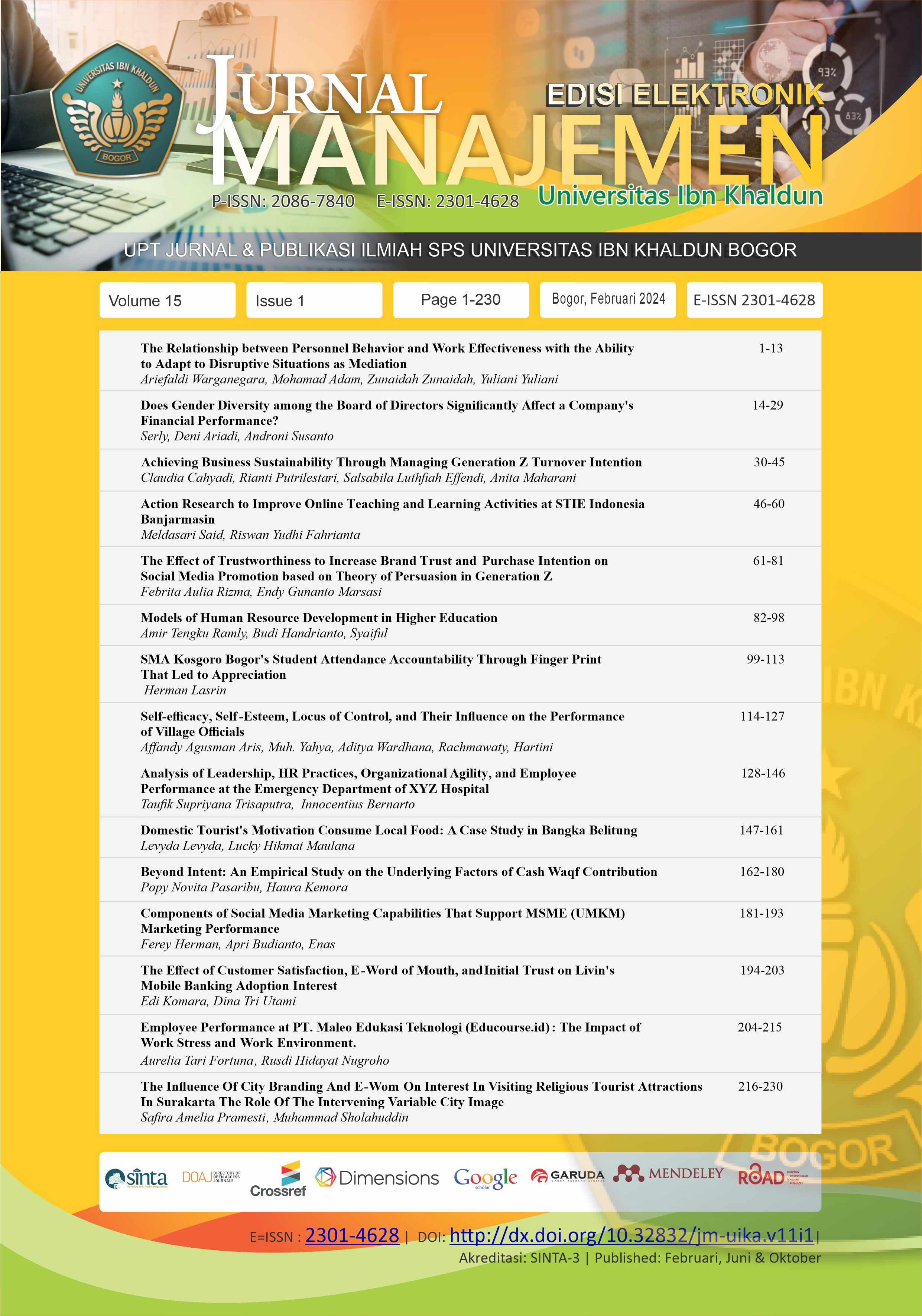Components of Social Media Marketing Capabilities That Support The Marketing Performance of Micro Small to Medium Enterprises (MSMEs)
DOI:
https://doi.org/10.32832/jm-uika.v15i1.16150Keywords:
Social Media, Marketing Performance, Marketing Capabilities, Resource-Based View Theory, Small and Medium EnterprisesAbstract
This paper aims to understand the importance of marketing capabilities in using social media on business performance. The conceptualization was developed based on Morgan’s marketing capabilities framework. Data was collected from SMEs in the food sector who just received a certificate for food safety, which means they have had the opportunity to market their product widely. Partial least squares structural equation modelling will be used to analyze data. The results of this study will have some limitations/implications: First: The data was collected using a non-probability sampling method, commonly known as convenience sampling. Second: Perceptual measures used on performance variables in this analysis. Third: This study neglects data changes from time to time, in
other words, this study obtains cross-sectional data collection. Finally, the study was only conducted in Tasikmalaya’s food sector and therefore does not lend itself to any general applicability. The originality of this study lies in the fact that this research is the first research that provides a complete view of social media applications in supporting SMEs in the food sector marketing performance.
References
Carnelley, J. A. (2018). The Components of Marketing Capability: A framework and processes of knowledge integration for development. In Journal of Chemical Information and Modeling. https://doi.org/10.1017/CBO9781107415324.004
Chahal, H., & Kaur, J. (2014). Development of marketing capabilities scale in banking sector. Measuring Business Excellence, 18(4), 65–85. https://doi.org/10.1108/MBE-06-2013-0037
Do Vale, G., Collin-Lachaud, I., & Lecocq, X. (2022). The new retail model: global reach demands omni-channels. Journal of Business Strategy, 43(6), 339–349. https://doi.org/10.1108/JBS-02-2021-0026
Fornell, C., & Larcker, D. F. (2016). Evaluating Structural Equation Models with Unobservable Variables and Measurement Error. Journal of Marketing Research This, 18(1), 39–50.
Gadde, L. E. (2020). From channel management towards network coordination – changing perspectives on distribution arrangements. Journal of Business and Industrial Marketing, 36(13), 14–25. https://doi.org/10.1108/JBIM-05-2020-0244
Garrido-Moreno, A., García-Morales, V., King, S., & Lockett, N. (2020). Social Media use and value creation in the digital landscape: a dynamic-capabilities perspective. Journal of Service Management, 31(3), 313–343. https://doi.org/10.1108/JOSM-09-2018-0286
Hair, J. F., Ringle, C. M., & Sarstedt, M. (2011). PLS-SEM: Indeed a silver bullet. Journal of Marketing Theory and Practice, 19(2), 139–152. https://doi.org/10.2753/MTP1069-6679190202
Kaleka, A., & Morgan, N. A. (2017). How marketing capabilities and current performance drive strategic intentions in international markets. Industrial Marketing Management, 78(January 2018), 108–121. https://doi.org/10.1016/j.indmarman.2017.02.001
Morgan, N. A. (2012). Marketing and business performance. Journal of the Academy of Marketing Science, 40(1), 102–119. https://doi.org/10.1007/s11747-011-0279-9
Murray, J. Y., Gao, G. Y., & Kotabe, M. (2011). Market orientation and performance of export ventures: The process through marketing capabilities and competitive advantages. Journal of the Academy of Marketing Science, 39(2), 252–269. https://doi.org/10.1007/s11747-010-0195-4
Nunnally, J. C., & Bernstein, I. H. (1994). Psychometric Theory (3th ed.). Mc Graw-Hill. Inc.
Sasatanun, P., & Charoensukmongkol, P. (2016). Antecedents and outcomes associated with social media use in customer relationship management of Thai microenterprises. International Journal of Technoentrepreneurship, 3(2), 127–149. https://doi.org/10.1504/IJTE.2016.080258
Syed Alwi, S. F., Balmer, J. M. T., Stoian, M. C., & Kitchen, P. J. (2022). Introducing integrated hybrid communication: the nexus linking marketing communication and corporate communication. Qualitative Market Research, 25(4), 405–432. https://doi.org/10.1108/QMR-09-2021-0123
Tarsakoo, P., & Charoensukmongkol, P. (2019a). Contribution of Marketing Capability to Social Media Business Performance. Asean Journal of Management & Innovation, 6(1), 75–87. https://doi.org/10.14456/ajmi.2019.6
Tarsakoo, P., & Charoensukmongkol, P. (2019b). Dimensions of social media marketing capabilities and their contribution to business performance of firms in Thailand. Journal of Asia Business Studies, 14(4), 441–461. https://doi.org/10.1108/JABS-07-2018-0204
Tsimonis, G., & Dimitriadis, S. (2014). Brand strategies in social media. Marketing Intelligence and Planning, 32(3), 328–344. https://doi.org/10.1108/MIP-04-2013-0056
Vorhies, D. W., & Morgan, N. A. (2003). A configuration theory assessment of marketing organization fit with business strategy and its relationship with marketing performance. Journal of Marketing, 67(1), 100–115. https://doi.org/10.1509/jmkg.67.1.100.18588
Downloads
Published
How to Cite
Issue
Section
License
Copyright (c) 2024 Jurnal Manajemen (Edisi Elektronik)

This work is licensed under a Creative Commons Attribution-NonCommercial 4.0 International License.
Authors who publish with this journal agree to the following terms:
- Authors retain copyright and grant the journal right of first publication with the work simultaneously licensed under a Creative Commons Attribution-NonCommercial-ShareAlike 4.0 International License that allows others to share the work with an acknowledgement of the work's authorship and initial publication in this journal.
- Authors can enter into separate, additional contractual arrangements for the non-exclusive distribution of the journal's published version of the work (e.g., post it to an institutional repository or publish it in a book), with an acknowledgement of its initial publication in this journal.
- Authors are permitted and encouraged to post their work online (e.g., in institutional repositories or on their website) prior to and during the submission process, as it can lead to productive exchanges, as well as earlier and greater citation of published work (See The Effect of Open Access).











